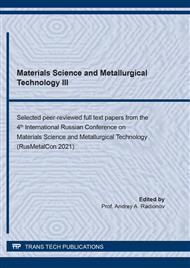[1]
A.I. Karlina, V.V. Kondrat'ev, A.D. Kolosov, A.E. Balanovskiy, Production of new nanostructures for modification of steels and cast irons, IOP Conference Series Materials Science and Engineering. 560 (2019) 012183.
DOI: 10.1088/1757-899x/560/1/012183
Google Scholar
[2]
S. Yang, R. Pelton, A. Raegen, M. Montgomery, and K. Dalnoki-Veress, Nanoparticle flotation collectors: mechanisms behind a new technology, Langmuir. 27(17) (2011) 10438-10446.
DOI: 10.1021/la2016534
Google Scholar
[3]
X. Dong, H. Marway, E. Cranston, and R. Pelton, Relating nanoparticle shape and adhesiveness to performance as flotation collectors, Industrial & Engineering Chemistry Research. 55(36) (2016) 9633-9638.
DOI: 10.1021/acs.iecr.6b02488
Google Scholar
[4]
V.V. Kondratyev. N.V. Nemchinova, N.A. Ivanov, I.A. Sysoev, New technological solutions for processing silicon and aluminum production, Metallurg. 5 (2013) 92-97.
Google Scholar
[5]
A.E. Balanovskii, Structure of the welding arc cathode spot with a nonconsumable electrode, High Temp. 56 (2018) 1-9.
DOI: 10.1134/s0018151x17060025
Google Scholar
[6]
V.V. Kondratiev et al, Processing and application of ultra disperse wastes of silicon production in construction, IOP Conf. Ser.: Mater. Sci. Eng. 463 (2018) 032068.
DOI: 10.1088/1757-899x/463/3/032068
Google Scholar
[7]
S.S. Kaprielov, A.V. Sheinfeld, Yu. R. Krivoborodov, Influence of the structure of cement stone with additives of microsilica and superplasticizer on the properties of concrete, Concrete and Reinforced Concrete. 7 (1992) 4-7.
DOI: 10.1201/9781482296631-24
Google Scholar
[8]
S.S. Kaprielov, General patterns of formation of the structure of cement stone and concrete with the addition of ultrafine materials, Concrete and Reinforced Concrete. 4 (1995) 16-20.
Google Scholar
[9]
V.G. Batrakov, Evaluation of ultrafine waste from metallurgical industries as additives to concrete, Concrete and Reinforced Concrete. 12 (1990) 15-17.
Google Scholar
[10]
V.V. Kondratiev et al, Structure of enriched ultradisperse wastes of silicon production and concrete modified by them, IOP Conf. Ser.: Mater. Sci. Eng. 463 (2018) 042064.
DOI: 10.1088/1757-899x/463/4/042064
Google Scholar
[11]
V.V. Kondratyev, A.E. Balanovsky N.A. Ivanov, V.A. Yershov, M.V. Kornyakov, Evaluation of the effect of the composition of a modifier with nanostructured additives on the properties of gray cast iron, Metallurg. 5 (2014) 48-56.
Google Scholar
[12]
S.N. Lekakh, N.I Bestuzhev, Out-of-Furnace Processing of High-Quality Cast Iron in Mechanical Engineering, Science and Technology, Minsk, (1992).
Google Scholar
[13]
A.D. Sherman, A.A. Zhukov, Cast Iron, Metallurgiya, Moscow, (1991).
Google Scholar
[14]
E. Mardaras, R. González-Martínez, R. Bayon, L. Nastac, S. Méndez, Surface modification of ductile iron produced by an innovative in-situ casting technique, International Journal of Cast Metals Research. 33(23) (2020) 103111.
DOI: 10.1080/13640461.2020.1766278
Google Scholar
[15]
V.A. Chaikin, D.A. Boldyrev, N.V. Chaikina, Features of graphitizing modification of high-strength cast iron with mixed modifiers in the conditions of JSC AvtoVAZ,, Bulletin of the Magnitogorsk State Technical University named after G.I. Nosov. 4 (2007) 58-61.
Google Scholar
[16]
S.V. Davydov, A new approach to the classification of methods of modification, Metallurgy of Mechanical Engineering. 5 (2006) 5-9.
Google Scholar
[17]
A.E. Balanovskii, Invisible structure of the cathode spot of a welding arc with a tungsten anode and a film cathode burning in an inert gas, High Temp. 57 (2019) 8-16.
DOI: 10.1134/s0018151x19010012
Google Scholar
[18]
A.E. Balanovskii, A new mechanism of interaction between a welding arc discharge of reverse-polarity direct current and an aluminum surface, High Temp. 57 (2019) 784-797.
DOI: 10.1134/s0018151x19060063
Google Scholar
[19]
A.E. Balanovskii, Study of the attachment stage of a welding arc discharge of direct-current straight polarity on aluminum surface, High Temp. 56 (2018) 486-495.
DOI: 10.1134/s0018151x1804003x
Google Scholar
[20]
A.E. Balanovskii, Spark stage of welding arc discharge binding on an aluminum surface, High Temp. 56 (2018) 319-326.
DOI: 10.1134/s0018151x18030033
Google Scholar
[21]
N.N. Ivanchik et al, Capability enhancement of production of activating fluxes for arc welding using ultradispersed products of silicon waste processing, Materials Science and Engineering. 411(1) (2018) 012035.
DOI: 10.1088/1757-899x/411/1/012035
Google Scholar
[22]
M.M. Savitsky et al, Features of welding of steels with a tungsten electrode with activating fluxes, Automatic Welding. 1 (1999) 20-28.
Google Scholar
[23]
S.G. Parshin, Application of activating materials in argon-arc welding, Welding Production. 6 (2003) 40-43.
Google Scholar
[24]
O. Savytsky et al, Influece of the impurities on the depth of penetration with carbon steel weldings, Metalurgija. 2 (2014) 167-170.
Google Scholar
[25]
J. Niagaj, M.M. Savytckyj, O.M. Savytckyj, The influence of activation on technological and ecological properties of welding arc under argon shield during welding of low - and high alloy steels, Biuletun Instytutu Spawalnictwa w Gliwicac. 1 (2008) 46-50.
Google Scholar
[26]
M.V. Konstantinova, A.E. Balanovskiy, V.E. Gozbenko, S.K. Kargapoltsev, A.I. Karlina, M.G. Shtayger, E.A. Guseva. B.O. Kuznetsov, Application of plasma surface quenching to reduce rail side wear, IOP Conf. Ser.: Mater. Sci. Eng. 560 (2019) 012146.
DOI: 10.1088/1757-899x/560/1/012146
Google Scholar


